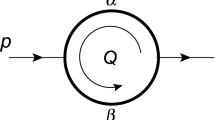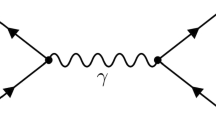Abstract
There is a rich interplay between algebraic geometry and string and gauge theories which has been recently aided immensely by advances in computational algebra. However, symbolic (Gröbner) methods are severely limited by algorithmic issues such as exponential space complexity and being highly sequential. In this paper, we introduce a novel paradigm of numerical algebraic geometry which in a plethora of situations overcomes these shortcomings. The so-called ‘embarrassing parallelizability’ allows us to solve many problems and extract physical information which elude symbolic methods. We describe the method and then use it to solve various problems arising from physics which could not be otherwise solved.
Similar content being viewed by others
References
Y.-H. He et al., Computational Algebraic Geometry in String and Gauge Theory, Adv. High Energy Phys. 2012 (2012) 431898.
J. Gray, Y.-H. He, V. Jejjala and B.D. Nelson, NSF/Microsoft Cloud Computing Grant CCF-1048082: Computing in the Cloud, a String Cartography, (2010).
J. Gray, Y.-H. He, V. Jejjala and B.D. Nelson, Vacuum geometry and the search for new physics, Phys. Lett. B 638 (2006) 253 [https://doi.org/hep-th/0511062] [https://doi.org/INSPIRE].
L.B. Anderson, Y.-H. He and A. Lukas, Heterotic Compactification, An Algorithmic Approach, JHEP 07 (2007) 049 [https://doi.org/hep-th/0702210] [https://doi.org/INSPIRE].
J. Gray, Y.-H. He, A. Ilderton and A. Lukas, A New Method for Finding Vacua in String Phenomenology, JHEP 07 (2007) 023 [https://doi.org/hep-th/0703249] [https://doi.org/INSPIRE].
J. Gray, A Simple Introduction to Grobner Basis Methods in String Phenomenology, Adv. High Energy Phys. 2011 (2011) 217035 [https://doi.org/arXiv:0901.1662] [https://doi.org/INSPIRE].
D.A. Cox, J. Little and D. O’Shea, Ideals, Varieties, and Algorithms: An Introduction to Computational Algebraic Geometry and Commutative Algebra, 3/e (Undergraduate Texts in Mathematics), Springer-Verlag, New York U.S.A. (2007).
J.C. Faugère, A new efficient algorithm for computing Gröbner bases (F4), J. Pure Appl. Algebra 139 (1999) 61.
J.C. Faugère, A new efficient algorithm for computing Gröbner bases without reduction to zero (F5), in ISSAC ’02: Proceedings of the 2002 international symposium on Symbolic and algebraic computation, New York U.S.A. (2002), pg. 75.
V.P. Gerdt, Involutive Algorithms for Computing Groebner Bases, https://doi.org/math/0501111.
G.-M. Pfister, G. Schönemann, H. Decker and W. Greuel, Singular 3-1-3 — A computer algebra system for polynomial computations (2011), https://doi.org/http://www.singular.uni-kl.de.
CoCoATeam, CoCoA: a system for doing Computations in Commutative Algebra, available at https://doi.org/cocoa.dima.unige.it.
D.R. Grayson and M.E. Stillman, Macaulay2, a software system for research in algebraic geometry, available at https://doi.org/www.math.uiuc.edu/Macaulay2/.
W. Bosma, J. Cannon and C. Playoust, The magma algebra system i: the user language, J. Symb. Comput. 24 (1997) 235.
J. Gray, Y.-H. He and A. Lukas, Algorithmic Algebraic Geometry and Flux Vacua, JHEP 09 (2006) 031 [https://doi.org/hep-th/0606122] [https://doi.org/INSPIRE].
J. Gray, Y.-H. He, A. Ilderton and A. Lukas, STRINGVACUA: A Mathematica Package for Studying Vacuum Configurations in String Phenomenology, Comput. Phys. Commun. 180 (2009) 107 [https://doi.org/arXiv:0801.1508] [https://doi.org/INSPIRE].
D. Mehta, Lattice vs. Continuum: Landau Gauge Fixing and ’t Hooft-Polyakov Monopoles, Ph.D. Thesis, University of Adelaide, Adelaide Australia (2009).
D. Mehta, A. Sternbeck, L. von Smekal and A.G Williams, Lattice Landau Gauge and Algebraic Geometry, https://doi.org/PoS(QCD-TNT09)025.
L. von Smekal, D. Mehta, A. Sternbeck and A.G. Williams, Modified Lattice Landau Gauge, https://doi.org/PoS(LATTICE 2007)382.
L. von Smekal, A. Jorkowski, D. Mehta and A. Sternbeck, Lattice Landau gauge via Stereographic Projection, https://doi.org/PoS(CONFINEMENT8)048.
D. Mehta and M. Kastner, Stationary point analysis of the one-dimensional lattice Landau gauge fixing functional, aka random phase XY Hamiltonian, Annals Phys. 326 (2011) 1425 [https://doi.org/arXiv:1010.5335] [https://doi.org/INSPIRE].
D. Mehta, Finding All the Stationary Points of a Potential Energy Landscape via Numerical Polynomial Homotopy Continuation Method, Phys. Rev. E 84 (2011) 025702 [https://doi.org/arXiv:1104.5497] [https://doi.org/INSPIRE].
D. Mehta, Numerical Polynomial Homotopy Continuation Method and String Vacua, Adv. High Energy Phys. 2011 (2011) 263937.
M. Kastner and D. Mehta, Phase Transitions Detached from Stationary Points of the Energy Landscape, Phys. Rev. Lett. 107 (2011) 160602 [https://doi.org/arXiv:1108.2345] [https://doi.org/INSPIRE].
D. Mehta, M. Kastner and J.D. Hauenstein, Energy landscape analysis of the two-dimensional nearest-neighbor φ4 model, Phys. Rev. E 85 (2012) 061103 [https://doi.org/arXiv:1202.3320].
M. Maniatis and D. Mehta, Minimizing Higgs Potentials via Numerical Polynomial Homotopy Continuation, (2012).
L. Casetti, R. Nerattini, M. Kastner and D. Mehta, Stationary Points Analysis of the 2D and 3D XY Model, to appear.
D. Hughes, C. Mehta and J.I. Skullerud, Enumerating Gribov Copies on the Lattice, to appear.
A.J Sommese and C.W. Wampler, The numerical solution of systems of polynomials arising in Engineering and Science, World Scientific Publishing Company, Singapore (2005).
T.Y. Li, Solving polynomial systems by the homotopy continuation method, in Handbook of numerical analysis. Vol. XI, North-Holland, Amsterdam Netherlands (2003), pg. 209.
D.J. Bates, J.D. Hauenstein, A.J. Sommese and C.W. Wampler, Adaptive multiprecision path tracking, SIAM J. Num. Anal. 46 (2008) 722.
D.J. Bates, J.D. Hauenstein, A.J. Sommese and C.W. Wampler, Stepsize control for adaptive multiprecision path tracking, Contemp. Math. 496 (2009) 21.
D.J. Bates, J.D. Hauenstein, A.J. Sommese and C.W. Wampler, Bertini: Software for numerical algebraic geometry, available at https://doi.org/www.nd.edu/∼sommese/bertini.
J. Verschelde, Algorithm 795: Phcpack: a general-purpose solver for polynomial systems by homotopy continuation, ACM Trans. Math. Soft. 25 (1999) 251.
T. Gunji, S. Kim, M. Kojima, A. Takeda, K. Fujisawa and T. Mizutani, Phom: a polyhedral homotopy continuation method for polynomial systems, Computing 73 (2004) 57.
A.P. Morgan, A.J. Sommese and L.T. Watson, Finding all isolated solutions to polynomial systems using hompack, ACM Trans. Math. Softw. 15 (1989) 93.
T. Gao, T.Y. Li and M. Wu, Algorithm 846: Mixedvol: a software package for mixed-volume computation, ACM Trans. Math. Softw. 31 (2005) 555.
T.L. Lee, T.Y. Li and C.H. Tsai, Hom4ps-2.0, a software package for solving polynomial systems by the polyhedral homotopy continuation method, Computing 83 (2008) 109.
D.N. Bernstein, The number of roots of a system of equations, Funkts. Anal. Pril. 9 (1975) 1.
A.G. Khovanski, Newton polyhedra and the genus of complete intersections, Funkts. Anal. Pril. 12 (1978) 51.
A.G. Kushnirenko, Newton polytopes and the bezout theorem, Funkts. Anal. Pril. 10 (1976) 82.
J.D. Hauenstein and F. Sottile, alphaCertified: Software for certifying numerical solutions to polynomial equations, available at https://doi.org/www.math.tamu.edu/∼sottile/research/stories/alphaCertified.
L. Blum, F. Cucker, M. Shub and S. Smale, Complexity and real computation, Springer-Verlag, New York U.S.A. (1998).
J.D. Hauenstein and F. Sottile, Algorithm 921: alphaCertified: certifying solutions to polynomial systems, to appear.
S. Gurrieri, A. Lukas and A. Micu, Heterotic on half-flat, Phys. Rev. D 70 (2004) 126009 [https://doi.org/hep-th/0408121] [https://doi.org/INSPIRE].
B. de Carlos, S. Gurrieri, A. Lukas and A. Micu, Moduli stabilisation in heterotic string compactifications, JHEP 03 (2006) 005 [https://doi.org/hep-th/0507173] [https://doi.org/INSPIRE].
A. Micu, E. Palti and P. Saffin, M-theory on seven-dimensional manifolds with SU(3) structure, JHEP 05 (2006) 048 [https://doi.org/hep-th/0602163] [https://doi.org/INSPIRE].
U.H. Danielsson, S.S. Haque, P. Koerber, G. Shiu, T. Van Riet, et al., de Sitter hunting in a classical landscape, Fortsch. Phys. 59 (2011) 897 [https://doi.org/arXiv:1103.4858] [https://doi.org/INSPIRE].
C. Caviezel, P. Koerber, S. Körs, D. Lüst, T. Wrase, et al., On the Cosmology of Type IIA Compactifications on SU(3)-structure Manifolds, JHEP 04 (2009) 010 [https://doi.org/arXiv:0812.3551] [https://doi.org/INSPIRE].
R. Flauger, S. Paban, D. Robbins and T. Wrase, Searching for slow-roll moduli inflation in massive type IIA supergravity with metric fluxes, Phys. Rev. D 79 (2009) 086011 [https://doi.org/arXiv:0812.3886] [https://doi.org/INSPIRE].
Y.-H. He, Lectures on D-branes, gauge theories and Calabi-Yau singularities, (2004).
J. Gray, Y.-H. He, V. Jejjala and B.D. Nelson, Exploring the vacuum geometry of N = 1 gauge theories, Nucl. Phys. B 750 (2006) 1 [https://doi.org/hep-th/0604208] [https://doi.org/INSPIRE].
J. Gray, A. Hanany, Y.-H. He, V. Jejjala and N. Mekareeya, SQCD: A Geometric Apercu, JHEP 05 (2008) 099 [https://doi.org/arXiv:0803.4257] [https://doi.org/INSPIRE].
D. Berenstein, Reverse geometric engineering of singularities, JHEP 04 (2002) 052 [https://doi.org/hep-th/0201093] [https://doi.org/INSPIRE].
D. Forcella, A. Hanany, Y.-H. He and A. Zaffaroni, The Master Space of N = 1 Gauge Theories, JHEP 08 (2008) 012 [https://doi.org/arXiv:0801.1585] [https://doi.org/INSPIRE].
D. Forcella, A. Hanany, Y.-H. He and A. Zaffaroni, Mastering the Master Space, Lett. Math. Phys. 85 (2008) 163 [https://doi.org/arXiv:0801.3477] [https://doi.org/INSPIRE].
J.D. Hauenstein, A.J. Sommese and C.W. Wampler, Regenerative cascade homotopies for solving polynomial systems, Appl. Math. Comput. 218 (2011) 1240.
A.J. Sommese and J. Verschelde, Numerical homotopies to compute generic points on positive dimensional algebraic sets, J. Complexity 16 (2000) 572 [https://doi.org/math/9906198].
D. Mehta, Y.-H. He and J. Hauerstein, Numerical Algebraic Geometry and Moduli Space of Vacua, to appear.
A. Belavin, A.M. Polyakov, A. Schwartz and Y. Tyupkin, Pseudoparticle Solutions of the Yang-Mills Equations, Phys. Lett. B 59 (1975) 85 [https://doi.org/INSPIRE].
M. Atiyah, N.J. Hitchin, V. Drinfeld and Y. Manin, Construction of Instantons, Phys. Lett. A 65 (1978) 185 [https://doi.org/INSPIRE].
E. Witten, σ-models and the ADHM construction of instantons, J. Geom. Phys. 15 (1995) 215 [https://doi.org/hep-th/9410052] [https://doi.org/INSPIRE].
S. Benvenuti, A. Hanany and N. Mekareeya, The Hilbert Series of the One Instanton Moduli Space, JHEP 06 (2010) 100 [https://doi.org/arXiv:1005.3026] [https://doi.org/INSPIRE].
S. Benvenuti, B. Feng, A. Hanany and Y.-H. He, Counting BPS Operators in Gauge Theories: Quivers, Syzygies and Plethystics, JHEP 11 (2007) 050 [https://doi.org/hep-th/0608050] [https://doi.org/INSPIRE].
T.-Y. Li and C.-H. Tsai, Hom4ps-2.0para: Parallelization of hom4ps-2.0 for solving polynomial systems, Parallel Comput. 35 (2009) 226.
T.Y. Li and X. Wang, The bkk root count in cn, Math. Comp.65 (1996) 1477.
J.M. Rojas, A convex geometric approach to counting the roots of a polynomial system, Theor. Comput. Sci. 133 (1994) 105.
J.M. Rojas and X. Wang, Counting affine roots of polynomial systems via pointed newton polytopes, J. Complexity 12 (1996) 116.
Author information
Authors and Affiliations
Corresponding author
Additional information
ArXiv ePrint: https://doi.org/1203.4235
Rights and permissions
About this article
Cite this article
Mehta, D., He, YH. & Hauenstein, J.D. Numerical algebraic geometry: a new perspective on gauge and string theories. J. High Energ. Phys. 2012, 18 (2012). https://doi.org/10.1007/JHEP07(2012)018
Received:
Accepted:
Published:
DOI: https://doi.org/10.1007/JHEP07(2012)018




